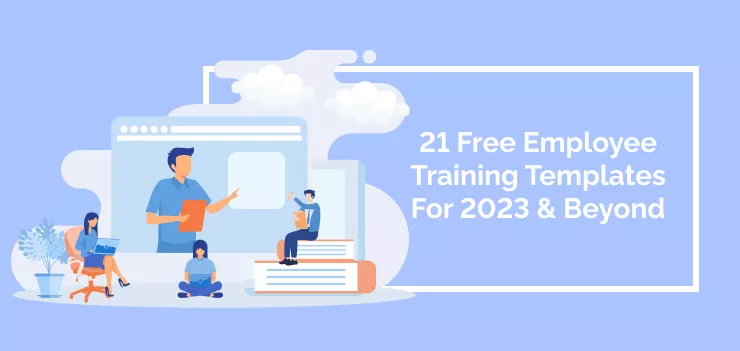
Employee training templates are a valuable tool to support organizational development.
Training programs are at the heart of a happy workforce. But the whole process can be unsystematic, challenging to monitor, and unpredictable. That’s where training templates come into play, covering every aspect of employee training.
Whether a company is training for digital adoption, compliance issues, or new management tasks, a template can help the process become much more manageable.
Digital transformation can be made more accessible by providing employees with a step-by-step guide they can refer to when learning new software or processes. Compliance templates help ensure everyone is updated on the latest regulations and best practices in their industry.
Change management also factors in here. Training templates make it easier for employers to plan out the details of implementing large-scale changes, including setting deadlines and outlining tasks for each team member. This helps ensure everyone is on the same page when learning new processes or updating existing ones.
Organizational change is often a significant undertaking, and employee training templates can make it much easier to stay on track. By providing employees with clear instructions and the tools they need to succeed, organizations are setting themselves up for success.
Training templates are an invaluable resource in any organization’s development toolkit.
A company can build templates from scratch, adapting to the precise needs of its workforce. However, there’s no need to reinvent the wheel. Company training sessions are nothing new. As a result, many training templates are freely available for implementation in new situations, taking managers from employee onboarding through to review questionnaires.
This article will explain how training templates can be valuable for developing a scalable training process. It will explain the meaning of a training template, examine its benefits, and introduce more than twenty freely available examples.\
What are employee training templates?
A template for an employee training plan is a document that provides a clear structure for any aspect of employee training.
It might include space for:
- Systems and routines
- Goals of the training program
- The proposed learning outcomes
- Time scales
- Training methods
- Training objectives
A consistent template for staff training helps make training consistent across an organization. Templates mean that staff understands the training process and how they will participate.
Training templates can also be valuable for reviewing training, implementing a business-wide training policy, or producing coherent documents that explain what areas staff needs to understand.
The benefits of employee training templates
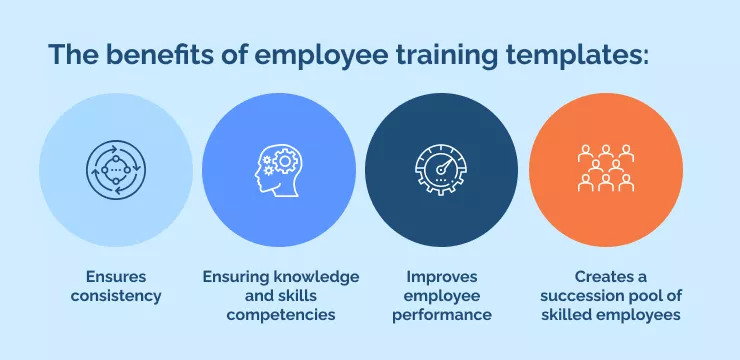
Implementing staff training templates can bring numerous advantages to an organization. The training process can often be inconsistent across different departments, teams, and individuals. Still, templates provide a foundation for management and employees alike to stay on track with what they need to do. Using templates for employee training plans is an excellent way to enhance efficiency and consistency throughout the organization. In the following section, we will examine five specific benefits that training plans can bring.
Ensures consistency
Achieving consistency through training plan templates ensures that all employees receive the same level of training and information. They help to make sure that staff has a clear understanding of their roles, which leads to improved job performance and productivity. Consistency also supports career development and facilitates progression for training from year to year.
For industries with compliance needs, they also help to ensure that staff is all meeting the requirements for regulations and safety in the workplace.
Ensuring knowledge and skills competencies
When training is consistently delivered and monitored, management can identify areas where employees across the company lack knowledge or skills, allowing them to target their training efforts in those areas. Consistent training templates help identify the employees’ specific and common knowledge gaps, ensuring they are equipped with the necessary knowledge and skills to achieve their and the company’s goals.
Improves employee performance
Consistent training documentation can improve employee performance by providing clear and standardized guidelines, ensuring all employees receive the same level of training, allowing for easy reference to past training materials, improving employee engagement, and providing a way to promote safety and compliance in the workplace. It is crucial for the employer and employees regarding job performance, job satisfaction, and the company’s overall success.
Creates a succession pool of skilled employees
With highly-skilled and happy employees, companies will automatically have a pool of candidates to progress to new managerial responsibilities. As staff moves through the ranks of the company, niche and specialized training can pick up where previous sessions left off.
Employee training template essentials

Training plan templates will include several key pieces of information.
- Training objective.
The first essential part of an employee training template is the training objective, outlining specific goals and objectives, including what the employee will be able to do after training and its alignment with the company’s overall goals.
- Training type
This section should specify the type of training being provided, such as on-the-job training, classroom-based training, web-based training, or e-learning, so that the employee can better understand the format and structure of the training.
- Key performance indicators (KPIs)
This section outlines the specific metrics and objectives used to measure the success of the training and the employee’s performance. It allows employees and employers to track progress, set clear goals, and make adjustments to improve employee performance.
- ROI measurables
This section should detail how the training will be evaluated and how it will impact the organization’s bottom line. It can include an increase in employee productivity, a reduction in errors or accidents, a decrease in turnover rates, and an increase in sales or revenue.
- Training methodology
Employees can see the approach and techniques used to deliver the training here. This can include what instructional design principles will be used, what activities or assessments will be employed, and how the trainer will evaluate the employee’s progress.
- Training material
Employees also need to have a run-down of the key resources for learning. These may include handouts, workbooks, slide presentations, assessments, and other materials that the employee will need to complete the training and how they can access it.
- Documentation of required digital resources
For more specialized training tasks, it may be essential to have access to specific digital resources. When employees need access to a scarce resource, it’s great to have a record of that in the training plan template. Then, they will know how to ensure they complete the training promptly.
- Employee participation list
This section will benefit the trainer more than the employees being trained. A participation list helps the trainer better understand their students’ needs from the get-go.
How to build an employee training plan from a template
Using an employee training template to create a full plan can make life easier for the trainer. However, it still takes time and consideration. Follow these three steps to produce an effective strategy:
- First, write down a list of topics that need to be covered in the training program. Ensure that these topics are relevant, up-to-date, and aligned with company objectives.
- Secondly, develop learning objectives for each topic; these should measure what employees gain from the training.
- Finally, create a template that can be used for each training session. This should include the topics, objectives, and delivery methods. It should also provide an overview of the expectations from both parties before, during, and after each session.
With these steps in place, any business will have all the elements required to create an effective employee training program that complements wider digital adoption strategies and goals.
21 Types of employee training program templates
The precise requirements for a template will change from company to company. However, one or more pre-existing templates can meet most business needs. These examples can be used as they are or adapted for an organization’s current needs.
- New-hire training template

Companies with good onboarding can expect to retain their staff for much longer. When managers welcome new hires as team members, they need to ensure that every area of the company becomes clear to them. To help with this process, Smartsheet has produced this template, which helps to cover every key area in which a new employee must be trained.
- Individual employee training template

Employees may need individualized training plans at any career stage, whether straight out of college, advancing up the management ladder, or seasoned C-suite leaders. Betterworks offer some great examples of how to do this.
- Employee development plan template
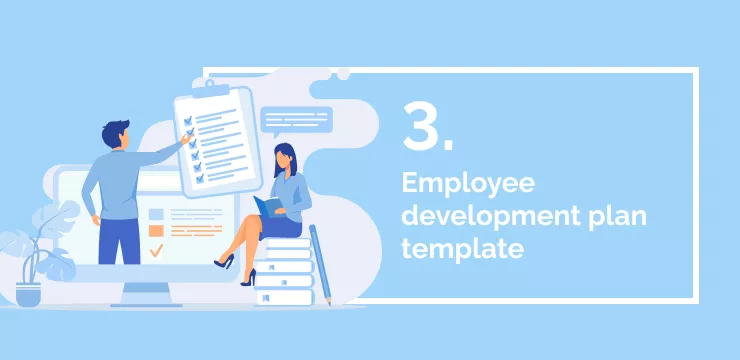
In an employee development plan, a staff member seeks to agree with their manager about the skills they need to acquire. It will usually offer targets with timescales, allowing all parties to understand how the individual is progressing. Indeed offer one useful sample template.
- Training policy template

As small businesses grow, they will reach a point where they need to have a centralized policy on training that applies to all their staff. See a sample template here.
- Training needs assessment template
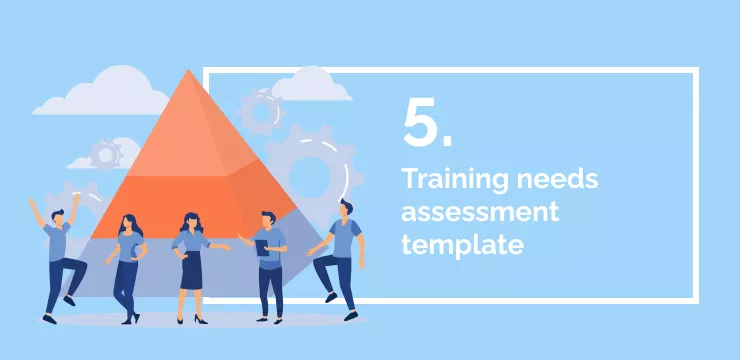
It’s essential to understand company-wide training needs, and there are many different approaches. Cognota offers five different resources for training needs analysis, guiding managers to ask the right questions at the right time.
- Employee training policy templates

Every part of staff training can benefit from existing templates, including the policies surrounding training itself. FactoHR has created a model policy that could be adapted to many companies.
- Standard operating procedure (SOP) template
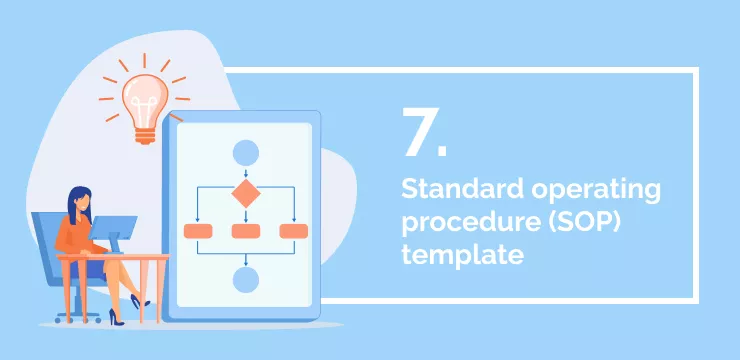
Standard operating procedures (SOPs) are essential to any business’s operations. SOPs provide clear guidance on how tasks should be carried out, helping employees understand their roles and responsibilities more clearly. As such, they are an essential part of training; this vital documentation ensures that staff remains updated. Getguru goes through the necessary elements in a good SOP.
- DEI training template
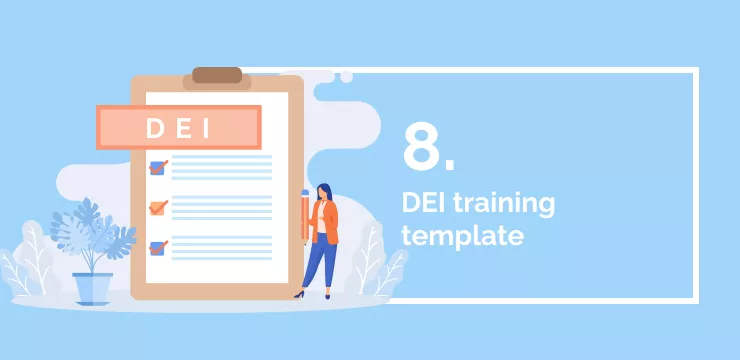
Diversity, Equality, and Inclusion training (DEI) are more important than ever. Some leaders may still be confused about how best to meet their responsibility in DEI matters. Fortunately, Zavvy has a DEI template that suggests a 15-day journey through 8 steps based on the Zavvy platform. This may only be right for some workplaces, but it will provide a starting point for producing new training materials.
- Skills gap analysis template

A skills gap analysis looks into the strengths and weaknesses of a company’s staff body. It is vital to understand how the business can improve its skillset without making new hires. Lorman provides one example of how to get to grips with a company’s weaknesses.
- Pre-training survey template

A pre-training survey helps to understand the learning stage of every team member. The outcomes benefit the staff responsible for the training, as they can pitch their courses at the correct level. Surveysparrow has created an article with sample questions and a full template.
- SMART goals template

SMART stands for Specific, Measurable, Achievable, Relevant, and Time-bound. They are often used in training programs, as they provide a clear framework for success. Microsoft has a great template for clearly and consistently laying out SMART goals.
- Training plan template
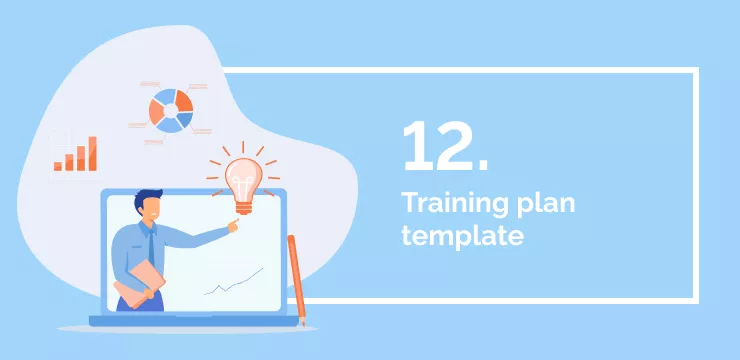
A training plan provides structure and guidance to ensure that employees receive the appropriate training in the skills they need. A good training plan should include timelines, deliverables, expectations from both parties, and any follow-up activities. There’s a great example of how to do this over at Helpjuice.
- 70-20-10 learning model template

The 70-20-10 learning model is a useful tool for creating training programs that are more effective and efficient. The model breaks down the learning process into three parts: 70% from experience, 20% from interactions with others, and 10% from formal instruction. With such a clear breakdown, it’s imperative to have the structure laid out in a clear format. A visual layout, like this example from SlideEgg, can be incredibly compelling to present this information.
- Leadership training plan template

A leadership training plan differs from regular training plans in that it focuses on developing soft skills and competencies, such as communication, problem-solving, and decision-making. The content for these plans also tends to be more experiential and interactive, such as simulations or role-playing activities. Torch gives one template for how to create such a plan.
- Return on Investment (ROI) calculator

Calculating the return on investment (ROI) for employee training is a process that requires some math but ultimately yields important insights. An automated calculator will include space for all relevant costs and financial benefits. These costs will include the total cost of the training program, including all associated expenses. The projected benefits from the program may include improved productivity or reduced errors. Learnupon has created a handy spreadsheet template to support these calculations.
- Post-training employee questionnaire template

A post-training employee questionnaire is an important tool for gauging the effectiveness of training programs. It allows trainers to get feedback from employees on their experience with a particular training session and what areas could still improve. This can help trainers identify any weak points in their training process and adjust accordingly to ensure that all employees have a successful training experience. Check out Survey Monkey for help deciding on questions.
- Training effectiveness feedback form
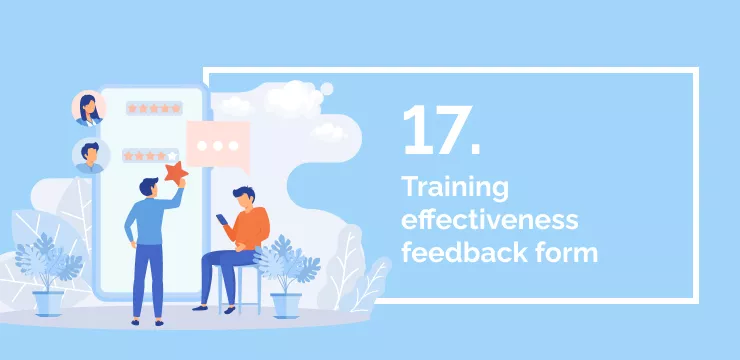
A feedback form is like a smaller version of a post-training questionnaire. It will ask for information about one specific aspect of the training program, whether a particular session, trainer, or training method.
- Technical training checklist

Technical training is focused on teaching employees the technical skills necessary to do their job. This includes software or hardware operation, coding, programming, network administration, etc. A standardized checklist can be handy for helping staff adjust to new tasks. (As a technical training checklist will be very specific to the task, we won’t include a link here!)
- Training matrix template
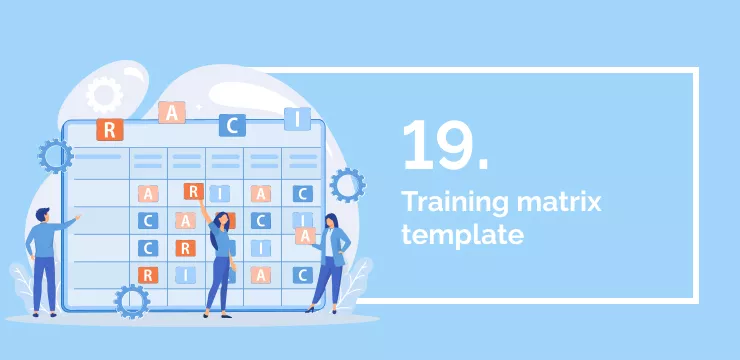
A training matrix is a document used to track and manage employee training. It lists each employee by name, the type of training they have completed, and any additional training required or recommended. For new line managers, constructing a training matrix may be daunting. Fortunately, Upwork offer three examples that any business can use.
- Product training template
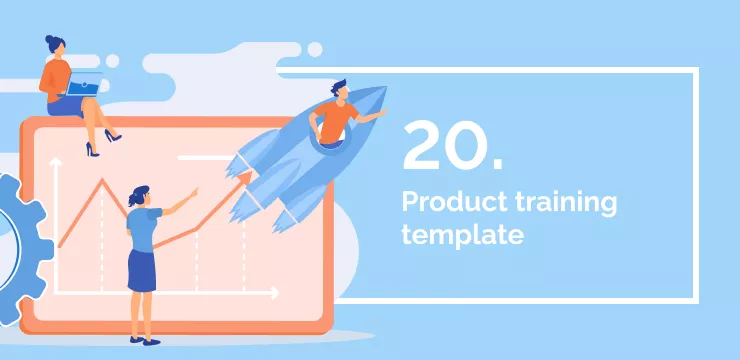
Product training helps employees understand a product’s features, functions, and uses. Product training typically focuses on how to use the tools efficiently, troubleshooting techniques, and tips for optimizing workflow. Visme show us how this can be done effectively.
- Remote work policy template
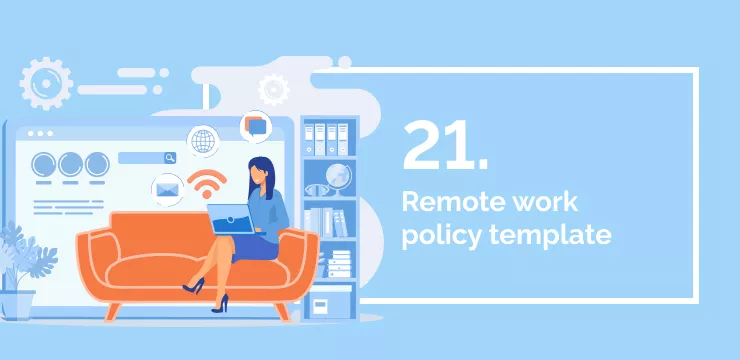
The configuration of working conditions is an important part of training, primarily when some employees work remotely. If staff don’t know their expectations, they won’t know how to perform adequately. A remote work policy is a great way to support staff in their daily performance. Indeed gives an excellent template here.
Take your training to the next level with templates

An April 2021 McKinsey report suggested that “many organizations have put training on hold during the pandemic. But they cannot afford to postpone it any longer.” For companies catching up on lost time, templates can provide an easy solution.
Whatever training template you’re looking for, there’s a template available to help. Whether it’s to welcome new team members, enhance the existing skills of current staff, or produce strategic employee development plans, other companies have been there first.However, templates must be kept “fresh” from year to year. The importance of skills and training changes dramatically over time, and without a good strategy, there’s a risk that staff will end up learning things they don’t need. A 2020 Garter report explained how rapidly the core workplace skills change from year to year. Companies that review their plans and templates carefully can expect to fully harness their staff capacities from year to year.
WalkMe Team
WalkMe spearheaded the Digital Adoption Platform (DAP) for associations to use the maximum capacity of their advanced resources. Utilizing man-made consciousness, AI, and context-oriented direction, WalkMe adds a powerful UI layer to raise the computerized proficiency, everything being equal.



